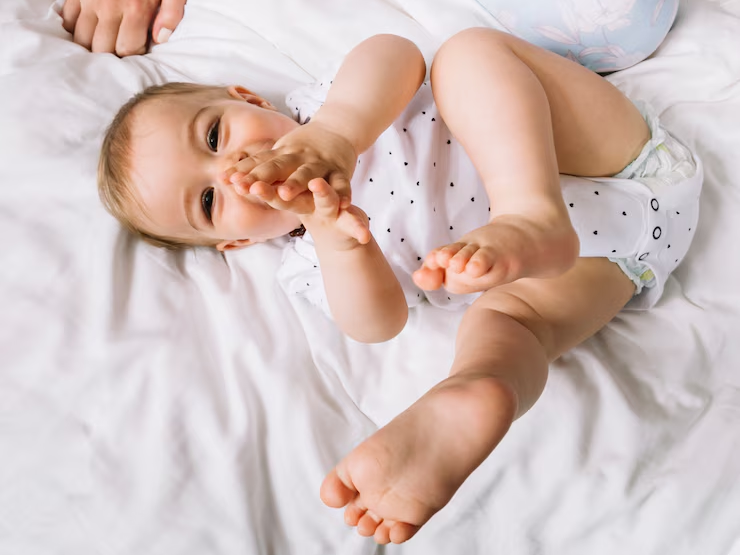
Summer brings sunshine and outdoor fun, but for babies, it can also mean uncomfortable, itchy, and soggy diapers that lead to restlessness and skin problems. Maintaining proper diaper hygiene becomes especially crucial during hot weather when humidity and heat create perfect conditions for rashes and irritation.
This comprehensive guide explores common diaper rash types that babies face during summer months and provides actionable tips for maintaining optimal diaper hygiene to keep your little one happy, comfortable, and protected.
Understanding Summer Diaper Rash Types
Before diving into prevention strategies, let’s understand what we’re protecting our babies from. Summer heat creates unique challenges for diaper hygiene, increasing the likelihood of these common rash types:
1. Irritant Diaper Rash
This most common type of diaper rash appears as pink or red patches in areas directly covered by the diaper. Also known as irritant dermatitis, it’s primarily caused by:
- Prolonged exposure to urine and stool
- Increased wetness from summer sweating
- Diarrhea episodes (more common in summer)
- Teething-related digestive changes
The skin appears inflamed, sometimes with small bumps, and typically feels warm to the touch. Proper diaper hygiene is your first line of defense against this uncomfortable condition.
2. Yeast Infection
Yeast infections thrive in the warm, moist environment that summer weather and diapers combine to create. These infections are characterized by:
- Bright red or pink patches with clearly defined edges
- Small pimple-like bumps around the main rash area
- Persistence despite regular cleaning and diaper changes
- Worsening after antibiotic treatment
Maintaining proper diaper hygiene with excellent air circulation becomes especially important for preventing yeast infections during hot weather.
3. Allergic Reactions
Some babies develop rashes as allergic responses to materials or ingredients in:
- Diaper materials or elastic bands
- Baby wipes (particularly those containing alcohol or fragrance)
- Diaper creams or powders
- Laundry detergents used on cloth diapers
The key identifier is that the rash appears precisely where the allergen contacts the skin. Effective diaper hygiene involves identifying and eliminating potential allergens from your baby’s care routine.
4. Bacterial Infections
Bacteria like staph or strep can cause rashes or intensify existing ones, particularly in hot weather when bacteria multiply faster. Signs include:
- Bright red skin around the anus (strep)
- Pimples with yellow crust (staph)
- Weeping or oozing from affected areas
- Increased pain or discomfort for your baby
Thorough diaper hygiene practices become essential when fighting or preventing bacterial infections.
5 Essential Diaper Hygiene Practices for Summer

Now that we understand what challenges summer brings, let’s explore five crucial diaper hygiene strategies to keep your baby comfortable and rash-free during hot weather:
1. Implement Proper Cleaning Techniques
Effective diaper hygiene begins with proper cleaning:
- Give gentle, lukewarm baths using mild, fragrance-free baby wash
- Clean the diaper area thoroughly during each change
- Wipe front to back (especially important for baby girls)
- Consider using plain water for cleaning instead of wipes when at home
- Pat the area dry instead of rubbing to prevent further irritation
- Allow the skin to air-dry completely before putting on a fresh diaper
Pro tip: Keep a spray bottle with clean water and a few drops of gentle baby oil to clean your baby’s bottom when changing diapers away from home. This creates less friction than wipes while maintaining excellent diaper hygiene.
2. Select High-Absorbency, Breathable Diapers
The right diaper choice forms the foundation of good diaper hygiene:
- Choose super-absorbent diapers designed specifically for extended protection
- Look for diapers with breathable materials that allow air circulation
- Select diapers with flexible, non-plastic elastic bands to reduce friction
- Consider sizing up during summer to increase airflow
- Evaluate whether your current diaper brand performs well in high humidity
Highly absorbent diapers prevent moisture from sitting against your baby’s skin, dramatically reducing the risk of rash development – a cornerstone of effective diaper hygiene.
3. Master the Art of Timely Diaper Changes
Frequency and timing of diaper changes significantly impact diaper hygiene:
- Change diapers more frequently during summer months
- Never leave a soiled diaper on your baby
- Check for wetness every 2-3 hours at minimum
- Change before and after naps and bedtime
- Learn to recognize your baby’s “need to change” signals
- Use the pinch test: gently pinch the diaper to check for moisture
Summer tip: Set a timer on your phone to remind you to check your baby’s diaper regularly during particularly hot days when rash risk increases. Consistent changing routines are essential to maintaining proper diaper hygiene.
4. Create a Gentle Between-Changes Routine
Maintain excellent diaper hygiene between full changes with these practices:
- Use alcohol-free, fragrance-free wipes (or water-moistened soft cloth)
- Clean with gentle patting motions rather than rubbing
- Apply a thin layer of diaper cream containing zinc oxide as a preventive barrier
- Avoid talcum powder, which can cause respiratory issues
- Consider occasional warm water rinses instead of wipes to reduce irritation
- Let the diaper area air-dry completely before putting on a fresh diaper
These gentle practices preserve your baby’s skin barrier while maintaining optimal diaper hygiene standards throughout the day.
5. Prioritize Airflow and Breathability
Excellent diaper hygiene includes maximizing air circulation:
- Give your baby regular diaper-free time on a waterproof mat
- Choose diapers with breathable side panels for better air circulation
- Dress your baby in loose cotton clothing that doesn’t trap heat
- Avoid plastic pants or tight clothing over diapers
- Consider slightly looser diaper fits during extremely hot weather
- Ensure the diaper waistband isn’t too tight
Increased airflow reduces moisture buildup and heat, significantly improving diaper hygiene during challenging summer months.
Additional Summer Diaper Hygiene Tips for Special Situations

Beyond the essential practices, these specialized diaper hygiene tips address specific summer challenges:
For Swimming and Beach Days
Maintain excellent diaper hygiene during water activities:
- Use specialized swim diapers designed not to swell in water
- Change out of wet swim diapers immediately after swimming
- Rinse your baby’s diaper area with clean water after pool exposure
- Allow the skin to dry completely before putting on a regular diaper
- Consider applying a thin protective barrier cream before water activities
For Travel and On-the-Go Situations
Keep up with diaper – hygiene while traveling:
- Pack extra diapers – hot weather may require more frequent changes
- Bring a portable changing pad for clean surfaces
- Use resealable bags for soiled diapers
- Consider travel-sized barrier creams for protection on the go
- Plan regular changing breaks during long car rides
For Nighttime Protection
Maintain diaper hygiene overnight with these strategies:
- Use overnight-specific diapers with maximum absorbency
- Apply a protective barrier cream before bedtime
- Consider sizing up for nighttime to improve air circulation
- Use breathable sleepwear that doesn’t trap additional heat
- Check and change early-morning diapers promptly
When to Seek Medical Attention
While good diaper – hygiene prevents most problems, contact your pediatrician if you notice:
- Rash that doesn’t improve after 2-3 days of home care
- Blisters, pus, or weeping from affected areas
- Rash spreading beyond the diaper area
- Signs of pain when your baby urinates or passes stool
- Fever accompanying the diaper rash
- Deep red, raised patches with defined borders (possible yeast infection)
The Bottom Line on Summer Diaper Hygiene

Maintaining excellent diaper hygiene during summer months requires extra attention but pays tremendous dividends in your baby’s comfort and happiness. By implementing these five key strategies, proper cleaning, choosing the right diapers, changing promptly, creating gentle routines, and maximizing airflow—you’ll dramatically reduce your baby’s risk of uncomfortable diaper rashes.
Remember that consistent diaper – hygiene practices are far easier than treating established rashes. With these preventative measures in place, your little one can enjoy a comfortable, rash-free summer filled with exploration and joy rather than irritation and discomfort.
What summer diaper hygiene practices have worked best for your baby? Share your experiences in the comments below!
References :
Polcari, I. Common Diaper Rashes & Treatments; Healthy Children
Yeast Diaper Rash; Cleveland Clinic
Also Read :
The Early Childhood Learning Process from Baby to Preschool!



